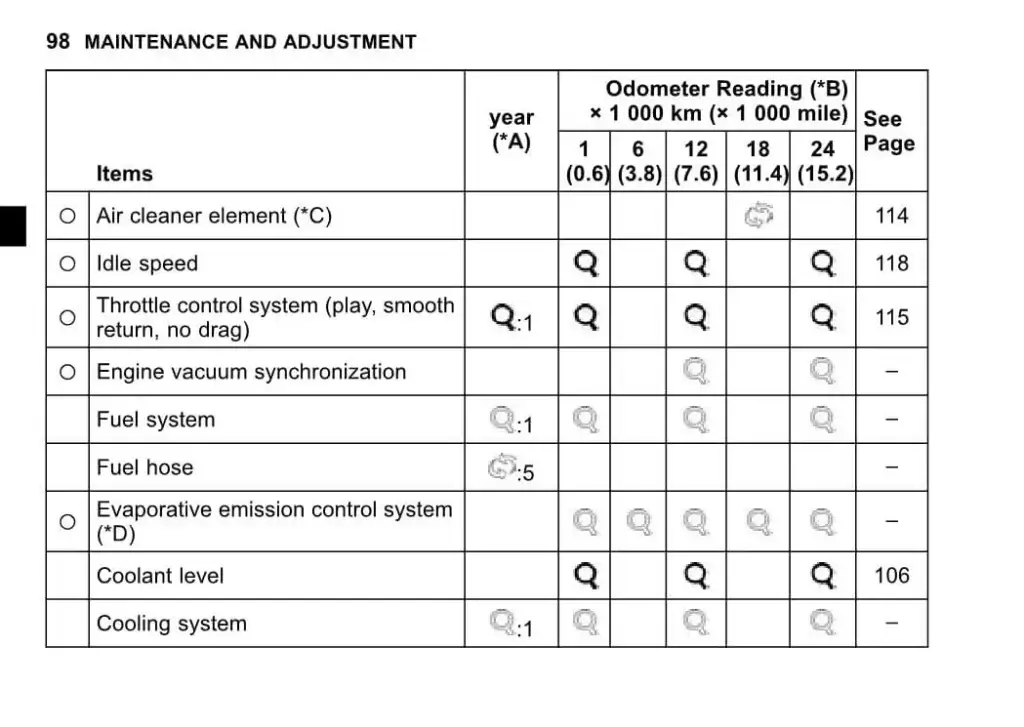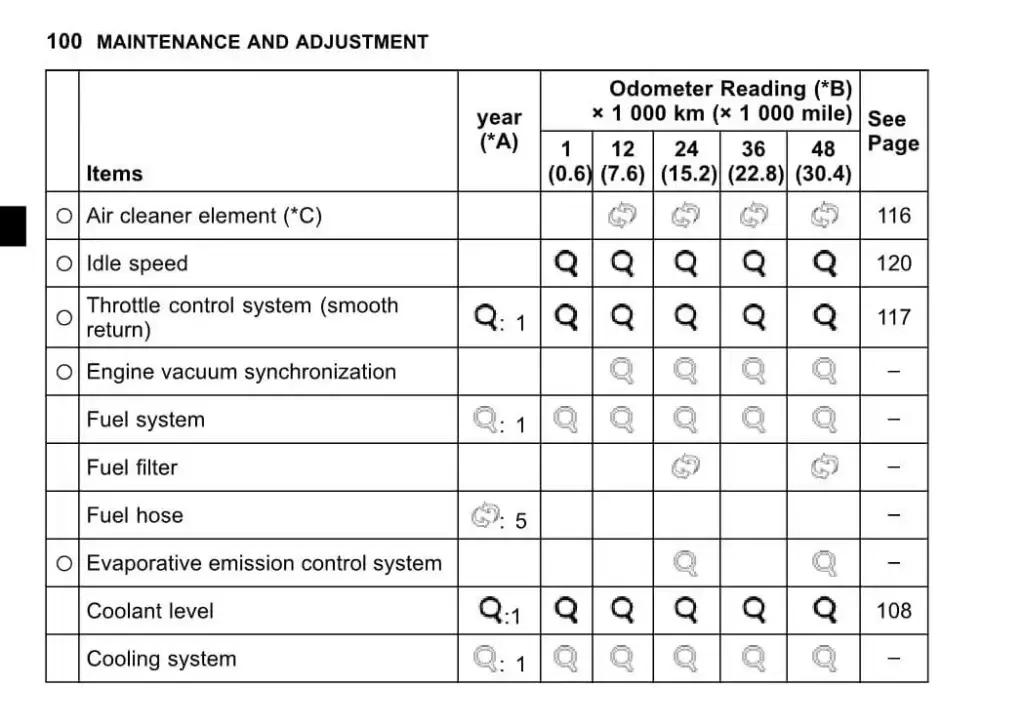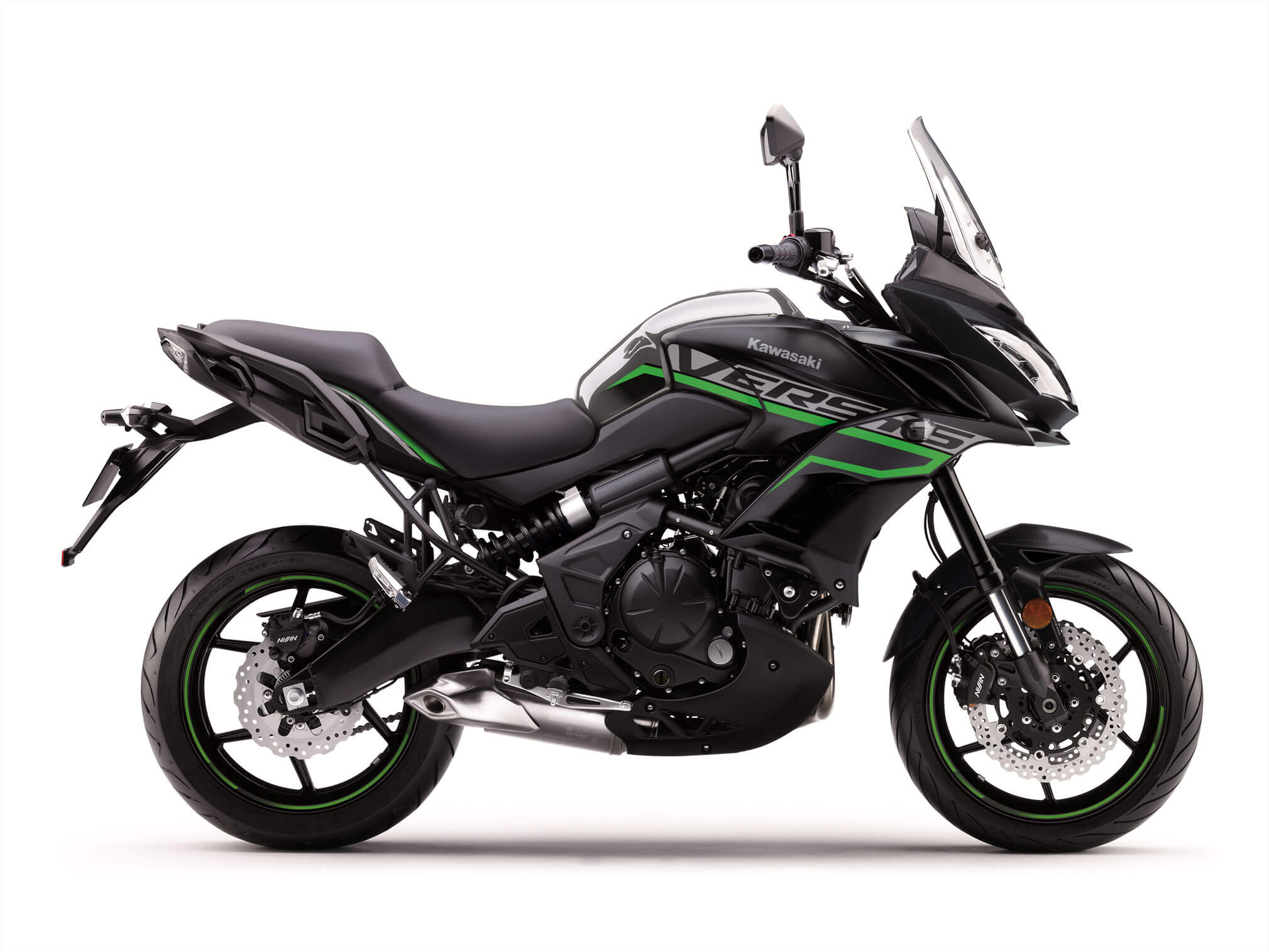From 2015 to the present, this is the maintenance plan with corresponding service intervals for the Kawasaki Versys 650 Mk3.
The Versys 650 has seen a few major improvements during its lifetime, but the engine and basic design have remained substantially the same (though a few parts have changed).
- Mk1 2007-2009: The original! A well-received bike, just thought of as a little buzzy.
- Mk2 2010-2014: Updated fairing (still a stacked headlight), rubber engine mounts and foot-pegs to reduce vibration. Optional (standard in some markets) ABS and heated grips.
Parts and maintenance for the Gen 1 and Gen 2 are quite similar. You can find the Versys 650 Mk1 and the Versys 650 Mk2 maintenance schedules in their respective service manuals on sale here.
- Gen 3 2015+: Re-tuned engine for 3 more kW (5 more hp), new look (twin headlights) with adjustable windscreen, updated front Showa suspension and rear KYB shock with remote pre-load adjuster, standard ABS, updated front Nissin brakes and 30mm larger rear disc
In the United States, the 2015 model is also available as an LT (“Light Touring”) variant, with hand guards and large side baggage that can fit a helmet in each case.
All variants of the Kawasaki Versys 650 have featured a fuel-injected 649cc parallel twin from its stablemate the Ninja 650 at its heart, producing a modest 50 kW (70hp) not too far up in the rpm range. It has enough power to keep you hustling at highway speeds (far into the double digits with plenty of power for passing — but you may need to downshift if you’re carrying a passenger).
The Kawasaki Versys 650 is only offered in select areas as a low-power learner-compliant model. The maintenance for these versions is same.
What you need to service the Kawasaki Versys 650
The following consumables and components are required for servicing the Kawasaki Versys 650.
Versys 650 owners are very serious home maintenance types, but if you’re lacking in basic tools, take a look at our list of maintenance items to see what more you could need. Partzilla.com has these components at a very reasonable price.
| Part | Kawasaki Versys 650 Spec |
|---|---|
| Oil | You need 1.6-1.8L of SAE 10W-40 engine oil “with API SG, SH, SJ, SL or SM with JASO MA, MA1 or MA2 rating”, preferably Kawasaki 10W-40 Engine Oil. Don’t over-torque the drain bolt (spec is 30 Nm/22 lb-ft per the manual) — use a torque wrench if you don’t have experience with how much torque is enough. |
| Oil filter | Oil filter is part 16097-0008, or you can use Hiflofiltro HF303RC. Torque for oil filter is 17.5 Nm (12.9 ft-lb) (use a torque wrench, and it’s easier on the K&N one) |
| Front brake pads | Get double-sintered EBC brake pads for better bite and wear. You need FA142HH (get 2 pairs). |
| Rear brake pads | Get double-sintered EBC brake pads for better bite and wear. You need a different part for year 2015 only. Year 2015 (only): FA140HH Years 2016+: FA174HH |
| Spark plugs | NGK CR9EIA-9, with a spark plug gap of 0.8-0.9mm (use a spark plug gapping tool), torqued to 15 Nm or 11 ft-lb (use a torque wrench) |
| Air filter | Use the K&N drop-in equivalent. The part number is KA-6415. |
| Cable lubricant | Remember to lubricate your clutch cable (and brake cables if you have them) with a cable lubricant. Protect All Cable Life is a good general-purpose lubricant. |
| Chain lubricant | The chain needs to be lubricated every 600 km/400 miles (or more, if it gets wet/dirty). Motul chain paste is cheap and well-loved. |
| Brake fluid | Spec is to use DOT-4 brake fluid. |
| Coolant | Use nitrate-free, phosphate-free, ethylene glycol-based coolant with anti-corrosion inhibitors, e.g. Valvoline Zerex G05 |
| Grease | Use a lithium soap-based grease for all the important greasing points. |
Maintenance Schedule for Kawasaki Versys 650
The maintenance plan for the Kawasaki Versys 650 from 2015 onwards is shown below. It has been simplified for exhibition purposes and to remove extraneous complexity. While the fundamental motorbike remained same from 2015 to 2018, the maintenance plan became much easier to follow beginning in 2018. That format is followed by the table below.
It has the same basic material as the previous model Versys 650, with only a few intervals modified.
The list of maintenance procedures must be performed on this motorbike is as follows, with a time or distance interval — whichever comes first.
- For higher odometer readings, repeat at the frequency interval established here.
- (*C) Service these items (oil, air filter, chain etc.) more frequently when operating in severe conditions: dusty, wet, muddy, high speed, or frequent starting/stopping.
| km x 1000 | 1 | 12 | 24 | 36 | 48 | |
|---|---|---|---|---|---|---|
| mi x 1000 | 0.6 | 7.6 | 15.2 | 22.8 | 30.4 | |
| Air cleaner element (*C) (Part KA-6415) (Note: earlier schedules recommended every 18K km) | R | R | R | R | ||
| Idle speed | I | I | I | I | I | |
| Throttle control system (smooth return) | I | I | I | I | I | Year, I |
| Engine vacuum synchronization | I | I | I | I | ||
| Fuel system | I | I | I | I | I | Year, I |
| Fuel filter (Note: Not mentioned in some earlier schedules) | R | R | ||||
| Fuel hoses | 5 years, R | |||||
| Evaporative emission control system (CA only) | I | I | ||||
| Coolant level | I | I | I | I | I | |
| Cooling system | I | I | I | I | I | Year, I |
| Coolant, water hoses, and O-rings (Coolant: Honda Coolant, it’s high-quality) | R | 3 years, R | ||||
| Valve clearance | I | I | ||||
| Air suction system | I | I | I | I | ||
| Clutch operation (play, engagement, disengagement) | I | I | I | I | I | |
| Engine oil (*C) and oil filter (Kawasaki 10W-40, HF303RC) | R | R | R | R | R | Year, R |
| Tire air pressure | I | I | I | I | Year, I | |
| Wheels and tires | I | I | I | I | Year, I | |
| Wheel bearing damage | I | I | I | I | Year, I | |
| Drive chain lubrication condition (*C) (Motul chain paste) | Every 600 km (400 mi), I | |||||
| Drive chain slack (*C) | Every 1000 km (600 mi), I | |||||
| Drive chain wear (*C) | I | I | I | I | ||
| Drive chain guide wear | I | I | I | I | ||
| Brake system | I | I | I | I | I | Year, I |
| Brake operation (effectiveness, play, no drag) | I | I | I | I | I | Year, I |
| Brake fluid level | I | I | I | I | I | 1/2 year, I |
| Brake fluid (front and rear) (Castrol DOT 4) | R | R | R,2 | |||
| Brake hose | R,4 | |||||
| Rubber parts of brake master cylinder and caliper | R | R,4 | ||||
| Brake pad wear (*C) | I | I | I | I | Year, I | |
| Brake light switch operation | I | I | I | I | I | Year, I |
| Suspension system | I | I | I | I | Year, I | |
| Steering play | I | I | I | I | I | Year, I |
| Steering stem bearings | L | L | 2 years, L | |||
| Electrical system | I | I | I | I | Year, I | |
| Spark plug (CR9EIA-9) | R | R | R | R | ||
| Chassis parts | L | L | L | L | Year, L | |
| Condition of bolts, nuts, and fasteners | I | I | I | I | I | – |
Tyre size and tyre pressure for the Kawasaki Versys 650
The Kawasaki Versys 650 has the following tyres, tyre sizes, and pressures.
| Tyre | Size | Tyre pressure |
|---|---|---|
| Front | 120/70 ZR17 M/C (58W) | 225 kPa/32psi |
| Rear | 160/60 ZR17 M/C (69W) | 250 kPa/36psi |
The tyres that came with the Versys 650 in 2015 and later are Dunlop D222, however other sport-touring tyres would work just as well.
Manual for the Kawasaki Versys 650 (2015+)
The above maintenance table comes from the 2021 Kawasaki Versys 650.
It has the same essential features as the 2015 model, but the schedule has been increased to 48,000 km. Despite having the same parts, some goods require more or less service.
E.g.
- The 2015 Versys 650 required the air cleaner to be changed every 18,000 km (11.4K miles). The 2021 Versys 650 recommends changing the filter more often, at 12,000 km (7.6K miles)
- The 2021 Versys 650’s schedule recommends changing the fuel filter every 24,000 km. The 2015’s schedule doesn’t mention it.
In conclusion, changing the air filter more or less frequently isn’t going to hurt, but replacing the fuel filter is an excellent addition to the timetable.


The above maintenance schedule comes directly from the user’s manual for the 2021 Kawasaki Versys 650.
Source: MaintenanceSchedule.net

